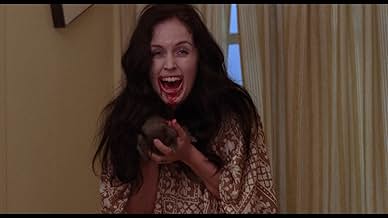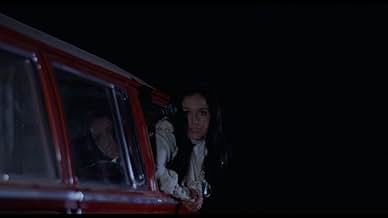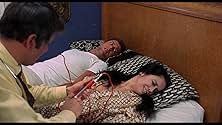IMDb-BEWERTUNG
5,7/10
3254
IHRE BEWERTUNG
Füge eine Handlung in deiner Sprache hinzuA couple invites a Count from Hungary, who recently immigrated to America, to conduct a seance for the woman's recently deceased mother, oblivious to the fact that he is actually a vampire.A couple invites a Count from Hungary, who recently immigrated to America, to conduct a seance for the woman's recently deceased mother, oblivious to the fact that he is actually a vampire.A couple invites a Count from Hungary, who recently immigrated to America, to conduct a seance for the woman's recently deceased mother, oblivious to the fact that he is actually a vampire.
Donna Anderson
- Donna
- (as Donna Anders)
Judy Lang
- Erica Landers
- (as Judith Lang)
George Macready
- Narration
- (Synchronisation)
Erica Macready
- Babette - the nurse
- (Nicht genannt)
Mark Tapscott
- Peter (seance guest)
- (Nicht genannt)
Stella Thomas
- Vampire Woman
- (Nicht genannt)
Empfohlene Bewertungen
When we think of great vampire portrayals, normally the names of Lugosi and Christopher Lee immediately pop into our heads. Robert Quarry, however, is as convincing a vampire as both of those great actors. His performance and demeanor as a Bulgarian Count in this film is truly outstanding. He lives in a large house somewhere in California and terrorizes young women and their boyfriends. What makes this picture a better than average vampire film is that it has a very tense and atmospheric plot structure. We basically know what fate will befall our innocent(just) protagonists, but we become riveted to their actions and those of the Count. Quarry plays the Count with a charm that is both amiable and yet caustic. He makes one of the wittiest vampires in film. The rest of the cast is adequate, and I think Roger Perry does a wonderful job as a blood specialist who goads Count Yorga one evening into talking about the supernatural. A must see for the classic horror fan.
In this alternate take on the Dracula story, the titular count (from Bulgaria) holds a seance to contact the mother of young Donna. Donna's mom died of some kind of anemia, which of course fits in with the movie's theme. The seance doesn't go as planned, but Yorga is able to implant some post-hypnotic control on poor Donna, and soon enough bodies are piling up as Donna and her friends try to figure out what's what. There's even a henchman who's (apparently) a werewolf! But aside from the present-day (well, 1970) atmosphere and setting, this is a movie useful only as a cult hit. Tired of the same old vampires? Try Count Yorga, sort of a Diet Dracula. As with many genre pics of the period, the acting and direction are pretty nondescript, and the whole thing looks like it was filmed through a screen door.
Not owning the rights to the Bram Stoker creation, AIP decided to invent their own vampire myth: the result is Dracula-in-all-but-name, being suave (sporting gracefully graying hair), cunning (even when caught off-guard, he manages to assert himself and turn the tables on interlopers), psychic (amusingly, he doubles as a medium at private séances!) and feral (his creepy dashes for prospective victims, seemingly out of nowhere, with blood-red eyes and arms outstretched actually gave me a jolt on a couple of occasions!). As played by Robert Quarry, he is quite creditable and effectively gave Christopher Lee (Hammer Film's Dracula incarnate) a run for his money.
Incidentally, he anticipated the other Count's transition to modern times by 2 years and actually managed it a whole lot better (with, thankfully, little resort to Camp). That said, in the attempt to look at the phenomenon with a contemporary mindset, we get a contradiction – people repeatedly scoff at the idea of vampirism in our age, claiming it is a fabrication of literature and cinema, which rather suggests that they are aware of what it entails and, yet, they are still surprised at what should be its predictable outcome and are required besides to pore over ancient tomes in search of a way to fight it! Though the film was given the alternate title of THE LOVES OF COUNT IORGA, VAMPIRE {sic}, which is actually borne by the copy I watched (for the record, this had been shown on local TV in my childhood but I first caught it years later on British Cable TV), it does not overstress the romantic angle. Indeed, one girl is shown quenching her unnatural thirst for blood by literally draining the life out of a kitten! The presence of a sinister (that is to say, hulking and deformed) acolyte is, admittedly, a bit of a cliché – but Yorga himself seems to have moved with the times (in spite of his traditional attire), since he is shown jadedly presiding over a lesbian vampire show in his living-room!
The stylish film was produced by Michael Macready (who also assumes the requisite heroic persona on-screen, though the doctor-turned-vampire-hunter played by Roger Perry actually has an even more central role!), son of distinguished character actor George Macready (who generously supplies the portentous narration here and which, at the start, erroneously refers to vampires as "The Living Dead"{!}: indeed, the whole film – scripted by Kelljan himself – aspires to a certain literariness but often merely results in being verbose which, however, it often works around by having characters conversing about the unusual events in which they had been thrust presented as voice-over laid on exterior crowd scenes!). The climax is a downbeat one: while Yorga is almost comically disposed of by being pierced (typically, through the heart) with a splintered broomstick, the lone-survivor hero sustains a vampiric attack from his own girlfriend (herself newly-inducted into the ranks of the Undead)! AIP presumably turned a fast profit with this one, seeing how they immediately commissioned a sequel (and whose own viewing followed that of the original in the current "Halloween Challenge"). However, they would soon come up with yet another (and even more outrageous) variation on vampire lore with the cult Blaxploitation offering BLACULA (1972) – which, in turn, led to the as-yet-unwatched SCREAM BLACULA SCREAM! (1973; helmed by Kelljan himself!)...
Incidentally, he anticipated the other Count's transition to modern times by 2 years and actually managed it a whole lot better (with, thankfully, little resort to Camp). That said, in the attempt to look at the phenomenon with a contemporary mindset, we get a contradiction – people repeatedly scoff at the idea of vampirism in our age, claiming it is a fabrication of literature and cinema, which rather suggests that they are aware of what it entails and, yet, they are still surprised at what should be its predictable outcome and are required besides to pore over ancient tomes in search of a way to fight it! Though the film was given the alternate title of THE LOVES OF COUNT IORGA, VAMPIRE {sic}, which is actually borne by the copy I watched (for the record, this had been shown on local TV in my childhood but I first caught it years later on British Cable TV), it does not overstress the romantic angle. Indeed, one girl is shown quenching her unnatural thirst for blood by literally draining the life out of a kitten! The presence of a sinister (that is to say, hulking and deformed) acolyte is, admittedly, a bit of a cliché – but Yorga himself seems to have moved with the times (in spite of his traditional attire), since he is shown jadedly presiding over a lesbian vampire show in his living-room!
The stylish film was produced by Michael Macready (who also assumes the requisite heroic persona on-screen, though the doctor-turned-vampire-hunter played by Roger Perry actually has an even more central role!), son of distinguished character actor George Macready (who generously supplies the portentous narration here and which, at the start, erroneously refers to vampires as "The Living Dead"{!}: indeed, the whole film – scripted by Kelljan himself – aspires to a certain literariness but often merely results in being verbose which, however, it often works around by having characters conversing about the unusual events in which they had been thrust presented as voice-over laid on exterior crowd scenes!). The climax is a downbeat one: while Yorga is almost comically disposed of by being pierced (typically, through the heart) with a splintered broomstick, the lone-survivor hero sustains a vampiric attack from his own girlfriend (herself newly-inducted into the ranks of the Undead)! AIP presumably turned a fast profit with this one, seeing how they immediately commissioned a sequel (and whose own viewing followed that of the original in the current "Halloween Challenge"). However, they would soon come up with yet another (and even more outrageous) variation on vampire lore with the cult Blaxploitation offering BLACULA (1972) – which, in turn, led to the as-yet-unwatched SCREAM BLACULA SCREAM! (1973; helmed by Kelljan himself!)...
Count Yorga (Robert Quarry), a vampire, comes from Bulgaria to 1970 Los Angeles and starts making a coven of beautiful female vampires. Will their boyfriends be able to stop him?
This was a huge hit in 1970 because it was the first modern vampire film. Up until then all vampire films had been set in Europe in the 1800s or early 1900s. This was the first vampire film set in modern day. Still it isn't a great film. It was originally shot with soft core sex scenes which were (pretty obviously) edited out and it was turned into a sleazy PG rated film. It was made on a very low budget (it shows) and suffers from some horrible 1970s fashions and dialogue. Also the makeup on the female vampires is pretty poor. Still this isn't a total disaster either.
The script is actually pretty intelligent considering this was a fairly rushed production. The acting is good--especially by Quarry who makes an imposing vampire. Very subtle performance but he handles the violent scenes quite well too. It moves at a fairly quick pace and has a great bloody climax--pretty extreme for a PG film. This won't impress audiences like it did in 1970 but it's still not that bad.
The 2000 video version I have has "Yorga" spelled as "Iorga".
This was a huge hit in 1970 because it was the first modern vampire film. Up until then all vampire films had been set in Europe in the 1800s or early 1900s. This was the first vampire film set in modern day. Still it isn't a great film. It was originally shot with soft core sex scenes which were (pretty obviously) edited out and it was turned into a sleazy PG rated film. It was made on a very low budget (it shows) and suffers from some horrible 1970s fashions and dialogue. Also the makeup on the female vampires is pretty poor. Still this isn't a total disaster either.
The script is actually pretty intelligent considering this was a fairly rushed production. The acting is good--especially by Quarry who makes an imposing vampire. Very subtle performance but he handles the violent scenes quite well too. It moves at a fairly quick pace and has a great bloody climax--pretty extreme for a PG film. This won't impress audiences like it did in 1970 but it's still not that bad.
The 2000 video version I have has "Yorga" spelled as "Iorga".
The early 70s were a great period for vampire movies. In England Hammer released some classics like 'The Vampire Lovers' and 'Vampire Circus', while Europe gave us some gems by Rollin, Franco and Larraz. America was not to be left out, and Bob Kelljan's 'Count Yorga, Vampire' is a great little movie that is often unfairly overlooked. Kelljan had acted in a couple of Richard Rush movies in the 60s including 'Psych-Out', before making a few exploitation movies of his own in the early- to mid-70s. For the rest of the decade he mainly concentrated on TV before sadly having his career cut short by cancer. As well as two Count Yorga movies he also directed 'Scream Blacula Scream' and the notorious 'Rape Squad'. 'Count Yorga, Vampire' is interesting because it is set in contemporary America, quite a rarity at the time. Robert Quarry ('Dr Phibes Rises Again') is excellent as Yorga. He's very charismatic and cool and I think this character deserved more than only two movies. The rest of the cast are pretty much unknown to me apart from Michael Murphy, an Altman semi-regular who also later appeared in 'Manhattan' and 'Magnolia'. He has made very few genre films but he can also be seen in 'Strange Behavior' and Wes Craven's 'Shocker'. I enjoyed 'Count Yorga, Vampire' a lot and highly recommend it to fans of 60s and 70s vampire movies.
Wusstest du schon
- WissenswertesThis film was originally conceived as a low budget softcore pornography film titled "The Loves of Count Iorga, Vampire". Later, however, the decision was made to film it as a regular horror film with the less erotic title "Count Yorga, Vampire" . This name change explains the poor animation of the name "Count Yorga" in the film's title as it now appears on-screen. The original title and original Iorga spelling were both restored to the film by the 1990s, but all prints of it were still identical to the original 1970 release. Apparently, no additional footage survives from its original porn version of it at all and it is unknown if said version was actually filmed or, if it was filmed, whether or not it was finished or even released if it was (it is worth noting, however, that the characters often pronounce the Count's name within the film as "Iorga" (ee-yor-ga) and not as "Yorga" (yor-ga)).
- PatzerCount Yorga's fangs are inconsistent throughout the entire film: sometimes all of his visible teeth are pointed, but in a few shots only his canines are pointed while his incisors are not.
- Zitate
Count Yorga: Doctor Hayes, what an unexpected surprise.
Dr. James Hayes: Yes, so much so that I almost had a massive coronary.
- Alternative VersionenThe new Twilight Time DVD version of the film contains a longer version of the kitten eating scene.
- VerbindungenEdited into Blacula (1972)
Top-Auswahl
Melde dich zum Bewerten an und greife auf die Watchlist für personalisierte Empfehlungen zu.
- How long is Count Yorga, Vampire?Powered by Alexa
- Who are the other vampire girls besides Erica?
- Why does Yorga target and turn Erica into a vampire?
- Why does Paul not stake Erica when given the chance and why does Erica pause after attacking him?
Details
Box Office
- Budget
- 64.000 $ (geschätzt)
Zu dieser Seite beitragen
Bearbeitung vorschlagen oder fehlenden Inhalt hinzufügen

Oberste Lücke
By what name was Junges Blut für Dracula (1970) officially released in India in English?
Antwort

























